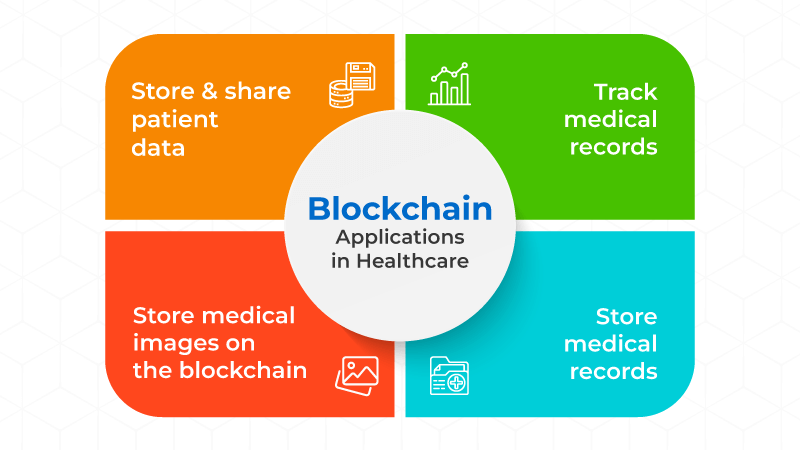Introduction
Blockchain is a technology that enables the creation of a digital ledger of transactions and data. Blockchain technology can be used to record any type of transaction, such as money or property exchanges. The most common use of blockchain technology is in cryptocurrency transactions, but it has many other applications too. These are resource-intensive applications that requires a website hosting infrastructure to run smoothly.
Blockchain is a technology that can be used to store and securely share data. It’s decentralized, meaning that it is not controlled by any one party.
Blockchain technology can be used to improve data security and interoperability between systems.
Many people believe that blockchain will serve as a major part of future society, but what does it do? In this article, we will explore how the blockchain works and how it can be used in healthcare to help make systems more transparent while also providing opportunities for greater efficiency at lower costs.
History of Block Chain Technology
Blockchain technology was invented in 2008 by an anonymous person or group of people known as Satoshi Nakamoto. Blockchain is a distributed ledger that records transactions across many computers, meaning there’s no central authority controlling it and no single point of failure. It’s the underlying technology behind Bitcoin (BTC), Litecoin (LTC), Ethereum (ETH), and other cryptocurrencies.
Blockchain can be used for a wide range of applications other than cryptocurrencies: financial services like banking or payment systems; supply chain management; healthcare record keeping; voting systems; public registries like land titles or birth certificates–and more! A blockchain works by storing data in “blocks” which are linked together into “chains” through cryptography and distributed across many computers around the world called miners who verify each transaction before adding it to their copy of this shared ledger.”
How can it be 3D Printing Technology used in Healthcare?
3D printing can be used to print prosthetic limbs for patients. It can also be used to print medical devices, medical supplies and equipment, and even instruments.
The most significant advantage of 3D printing technology is that it allows customization of the device based on the patient’s needs. This can help improve their quality of life by making them feel more comfortable with their disability or illness.
Related: How To Use Cloud To Solve Blockchain Challenges?
What is blockchain?
Blockchain technology is a distributed ledger. It’s a digital ledger of transactions, but unlike traditional ledgers, blockchains are decentralized and distributed across networks. The network can be public or private depending on how it’s set up–in either case, it will be peer-to-peer (P2P).
Blockchains are often compared with traditional databases because they both track information about things (like money) and make sure that data is accurate over time by recording new entries into blocks connected in chronological order via cryptographic hashes called “pointers.” Blockchains differ from traditional databases in several ways.
How does it work?
Blockchain technology is a distributed database system that uses a digital ledger to record transactions between two parties. It’s like an accounting ledger, but instead of being stored in one place and updated by a centralized authority, blockchains are distributed across many computers. This means there is no single point of failure for hackers to target and corrupt data (and also why it’s called “blockchain”).
Each transaction occurring on the blockchain is verified by multiple computers before being added to its history–a process known as consensus–which makes it virtually impossible for someone to alter historical records without other users noticing. The more people who participate in verifying these transactions, the harder they become for someone outside of those verifying them (like hackers) to change them undetected; this makes blockchains incredibly secure compared with traditional databases because you don’t need any special software installed on your computer before accessing them
Many people believe that blockchain will serve as a major part of future society, but what does it do?
The blockchain is a decentralized ledger. It’s a distributed database that keeps records of transactions, and it can be accessed by anyone with an internet connection. The records on the blockchain are immutable, meaning they cannot be changed or deleted once they’re recorded in the blockchain. This makes it ideal for storing medical records because there’s no possibility of tampering with them once they’re on there–and this ensures that patients have access to their information at all times (which is important when trying to navigate through different healthcare systems).
The different characteristics of Blockchain, such as decentralization, transparency, and security, have made it a very significant technology in multiple industrial applications. One of these domains is cloud computing and managed cloud services.
The technology behind Bitcoin has also been used in other industries such as finance, real estate, and even music streaming services like spottily where users pay artists directly instead of going through record labels who often take most profits away from musicians themselves.
Blockchain technology can be used to make healthcare more efficient, secure, and transparent.
- Blockchain technology can be used to make healthcare more efficient, secure, and transparent.
- Blockchain technology is a distributed ledger that allows two parties to transact with each other without having to trust or rely on a third party. This means that the information stored in the blockchain is immutable and tamper-proof, making it ideal for recording transactions between individuals or organizations securely.
- Blockchain allows healthcare providers access to patient records instantly while ensuring data privacy through encryption keys (this also allows patients greater control over their data).
Related: How Cryptocurrency Prices Impact Domain Names?
Healthcare providers can also use blockchain technology to verify the identities of patients before handing out medications or treatment plans.
Blockchain technology can also be used to verify the identities of patients before handing out medications or treatment plans. This helps to prevent fraud and theft, as well as medication errors.
Blockchain technology can also be used to verify the identity of healthcare providers, which will help ensure they are qualified for their jobs and that they are not performing procedures outside their scope of practice.
Blockchain Applications in Healthcare

Which are tamper-proof and unalterable once they’re uploaded into the system (as opposed to traditional methods of storing electronic documents). This is especially useful for storing digital scans of x-rays and other types of radiological images since it makes them impossible for hackers or criminals at any point after uploading them onto a blockchain network like Ethereum or Bitcoin Cash–and even if someone were able to get access through an initial breach of security measures in place by healthcare providers themselves (which happens surprisingly often), there wouldn’t be any way for them to alter these files without causing inconsistencies between different copies held within each block across all nodes connected via P2P links throughout all locations worldwide where these servers exist simultaneously under different jurisdictions;
This makes tampering attempts useless because any attempt would automatically result in failed verification checks performed against random nodes chosen randomly every time someone wants access without authorization privileges granted only by those people who hold keys necessary for revoking permissions granted previously so long as certain conditions are met beforehand such as submitting proof confirming identity verification via fingerprint scan followed by facial recognition software scanning before allowing access rights based on rules defined beforehand by whoever set up initial configuration settings before launching first node during initial installation process done manually by installing new version updates whenever available through manual intervention during setup process rather than automated updates running automatically behind scenes so users don’t have worry about anything happening behind closed doors later down road
Blockchain has the potential to transform healthcare
Blockchain has the potential to transform healthcare. Blockchain technology can help address issues related to data sharing, data security, and interoperability of different systems.
Blockchains are open-source, distributed ledger that makes it possible for anyone in a network (including patients) to add information or transactions securely without requiring permission from any central authority or middleman such as a bank.
The current healthcare ecosystem is facing several challenges
The current healthcare ecosystem is facing several challenges. Data sharing and data security are some of the biggest issues faced by the industry today. Blockchain technology has great potential to revolutionize healthcare because it can help address issues related to data sharing, data security, and interoperability of different systems.
Blockchain technology could offer a possible solution to these challenges.
Blockchain technology offers a potential solution to these challenges. Blockchain technology can help address issues related to data sharing, data security, and interoperability of different systems. It can also help in the reduction of fraud, waste, and costs by providing a secure platform for storing healthcare information that is accessible to all stakeholders involved in the process of care delivery.
A distributed ledger can be used to store all data in an encrypted format and all the stakeholders can access it.
Blockchain technology is a distributed ledger that can be used to store all data in an encrypted format and all the stakeholders can access it. The blockchain is a decentralized network of computers that have a copy of the ledger, which is a list of transactions stored on those computers.
The most important thing about blockchains is that they are transparent and immutable, making them ideal for storing sensitive healthcare data such as medical records (which would normally require patient consent) or pharmaceutical supply chain information (a potential target for hackers).
Related: Best Cryptocurrency WordPress Themes
A blockchain network promotes transparency, accountability, and efficiency.
Blockchain technology can be used to share data securely. It helps in tracking medical records, managing patient consent, tracking the pharmaceutical supply chain, and improving research and development.
Blockchain technology can also be used to prevent fraud and errors in healthcare.
Blockchain technology can help address issues related to data sharing, data security, and interoperability of different systems.
Blockchain technology can help address issues related to data sharing, data security, and interoperability of different systems.
Healthcare organizations are often slow to adopt new technologies due to the significant financial investment required to adopt them. In addition, healthcare providers must be able to demonstrate that their use of these technologies will improve outcomes while reducing costs.
The use of blockchain is becoming more common because it provides so many benefits
Blockchain is a distributed ledger technology, which means that it can be used to store and share data in an immutable way. It’s the technology behind bitcoin, but it has many other potential applications as well.
One of those applications is healthcare. Blockchain could be used to store medical records on a distributed ledger or verify patients’ identities when they visit hospitals or clinics (or even pharmacies). The same applies when we talk about sharing data: if you want something like an electronic health record system within an organization or between different organizations–for example, hospitals collaborating for research purposes–then blockchain will help make sure that information isn’t tampered with along the way. Another advantage of using blockchain over traditional systems is improved security; since all transactions are recorded on multiple computers at once and require consensus before being added permanently into new blocks (which then form part of an immutable chain), there’s no single point where hackers could access sensitive information like passwords or financial details.”
Blockchain technology is becoming more common in healthcare because of its many benefits. Blockchain technology has great potential to revolutionize healthcare. It can help address issues related to data sharing, data security, and interoperability of different systems. The current healthcare ecosystem is facing several challenges, which can be addressed by adopting this technology. Blockchain applications in healthcare will result in better patient outcomes and improved efficiency for providers















